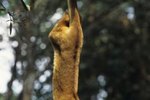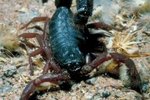
Capuchin monkeys are endemic to Central and South America. They are arboreal, and therefore spend most of their time up in the trees. Capuchins are most notable for their brains -- in fact, they are considered among the most intelligent New World primates. They are very cooperative, and are therefore kept as pets, used by street entertainers or even featured in television programs and films.
Natural Habitat
Capuchin monkeys are found in Argentina, Brazil, Costa Rica, Honduras, Paraguay and Peru. They tend to inhabit low-lying forests, mountain forests and rain forests. Such environments give them access to shelter and food. Capuchins are omnivores, and subsist on a diet of nuts, fruits, vegetation, flowers, bugs, eggs, reptiles and even small mammals, such as mouse opossums, all of which they can forage for very near their habitats during the daytime.
Swinging Around
Capuchin monkeys are very agile, which comes in handy in their forest habitat. They use their long, lean limbs and long tails to climb up trees and move through them. They also have opposable thumbs and big toes, which gives them the ability to hold onto branches tightly, while foraging for food. Capuchins are also great jumpers, and can jump as much as 9 feet from one tree to the next in a single leap.
Paying It Forward
Capuchin monkeys use the forest as a food supply during the day and as shelter at night, but they also give back to it. Their behavior is actually beneficial to the forest’s ecosystem. The monkeys spread seeds they have consumed either by dropping them or via their fecal matter, and thus help new plants grow. They also eat nectar, which helps to pollinate plants.
Sharp Cookies
Capuchin monkeys rarely leave the safety of the trees and stay high up. They are so sharp that if they have trouble finding food during their foraging, they will use tools to get it. They have figured out how to use stones to break nuts and hard fruit. When they do come down from the trees, it’s typically to get water from a nearby source. They will use stones to break open crabs and shellfish. Capuchins have even worked out how to deal with the inevitable mosquitoes in their habitat. They rub crushed millipedes on their fur, which deters the annoying insects.
References
Photo Credits
-
Ryan McVay/Digital Vision/Getty Images
Writer Bio
Vivian Gomez contributes to Retailing Today, the Daily Puppy, Paw Nation and other websites. She's covered the New York Comic Con for NonProductive since 2009 and writes about everything from responsible pet ownership to comic books to the manner in which smart phones are changing the way people shop. Gomez received her Bachelor of Arts in English literature from Pace University.



